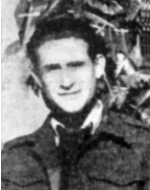Eliezer, son of Rysha and Zvi (Hirsch Leib), was born on May 6, 2222 in Poland, in the city of Volozhin (now in the Novogrudek region of the Belorussian Republic). Eliezer was educated in an elementary school and continued on to a Hebrew-Zionist high school, and on the eve of World War II, some 3,500 Jews lived in Volozhin, where the city was known for its ” , Famous Rabbis, sages, and poets.Nahim Nachman Bialik’s poem “The Matmid” describes to a great extent the experience of studying in this yeshiva: At the end of 1939, with the outbreak of the war, After the breakup of the alliance between Stalin and Hitler, the Germans occupied the area, and on July 25, 1941, the Germans entered the city and immediately afterwards a local mob began to riot, murder Jews and set fire to synagogues. In the autumn of 1941, the first Aktion took place, 200 Jews were executed together with the head of the Judenrat, and on May 10, 1942, some 1,700 Jews were rounded up near the bathhouse, stripped of their clothes, and shot to death. On August 29, 1942, the third Aktion took place, in which the remnants of the Jewish community were murdered. Between the Aktions, about 80 Jews from Volozhin managed to escape to the forests, among them Eliezer. The rest of his family were murdered in the ghetto. He joined the Russian partisans in the forests around Nalibok-Stolpec and participated in their attempts to damage the German war effort. With the advance of the front, national partisan divisions were established in the Soviet Union. One of them was the “Chaklov” Brigade, of which Eliezer was one of its members. He excelled in the war against the Nazi occupiers and was appointed as a liaison in the brigade, and in 1943 he was appointed commander of a 25-man sabotage company that engaged in mining roads, railroads and trains. In the course of his activity, Eliezer sabotaged 18 trains loaded with soldiers and ammunition, was promoted to lieutenant (lieutenant) and was awarded many honors, including the title and emblem of “Hero of the Soviet Union.” After the liberation of Volozhin in July 1944, Eliezer was appointed commander of the city’s secret service. Due to the accidental killing of a farmer, while trying to repair a machine that had been broken, was punished and sent to the front. In Vilna he killed a collaborator with the Nazis, who according to his knowledge had a part in the destruction of his family. At the end of the war Eliezer was released and allowed to return to Poland. When he arrived in the city of Lodz, he learned that all his family had been killed by the Nazis. He joined the “Gordonia” kibbutz, and later became one of its managers. He left Lodz with his comrades on the Bericha route. Later, Eliezer was active in the DP camps in Salzburg, Vienna and Italy as a Hebrew teacher and teacher, and assisted in the implementation of the illegal aliya Bet organized by the Haganah. While he was in Italy, he joined the Irgun (Irgun Zvai Leumi), and when he reached the Land of Israel, he was captured by the British and the rest of the immigrants was deported to Cyprus, Was allowed to immigrate to Israel, and immediately joined the 12th Brigade, the Negev Brigade of the Palmach, and since then participated in battles in the Negev during the War of Independence. He served in the Negev district headquarters as a sabotage officer – the profession he specialized in as a partisan. When the battles in the Negev ended, Eliezer was sent to dismantle mines in the territories that had been transferred to Israel. On December 26, 1948, when a mine exploded in the village of Muhraqa, about 15 kilometers east of Gaza, he was killed, Eliezer was twenty-six years old, and was brought to rest in the military cemetery in Rehovot. Eli ‘s stories of heroismEzer during the Holocaust is mentioned in Shalom Cholawski’s book “Mary and Partisan Warfare,” and on a page dedicated to Volozhin on the Yad Vashem website. This hero is a “last scion”. The survivors of the Holocaust are survivors of the Holocaust who survived the last remnant of their nuclear family (parents, brothers, sisters, sons and daughters) who experienced the Holocaust in the ghettos and / or concentration camps and / or in hiding and hiding in territories occupied by the Nazis and / Or in combat alongside members of the underground movements or partisans in the Nazi-occupied territories who immigrated to Israel during or after World War II, wore uniforms and fell in the Israeli army.
